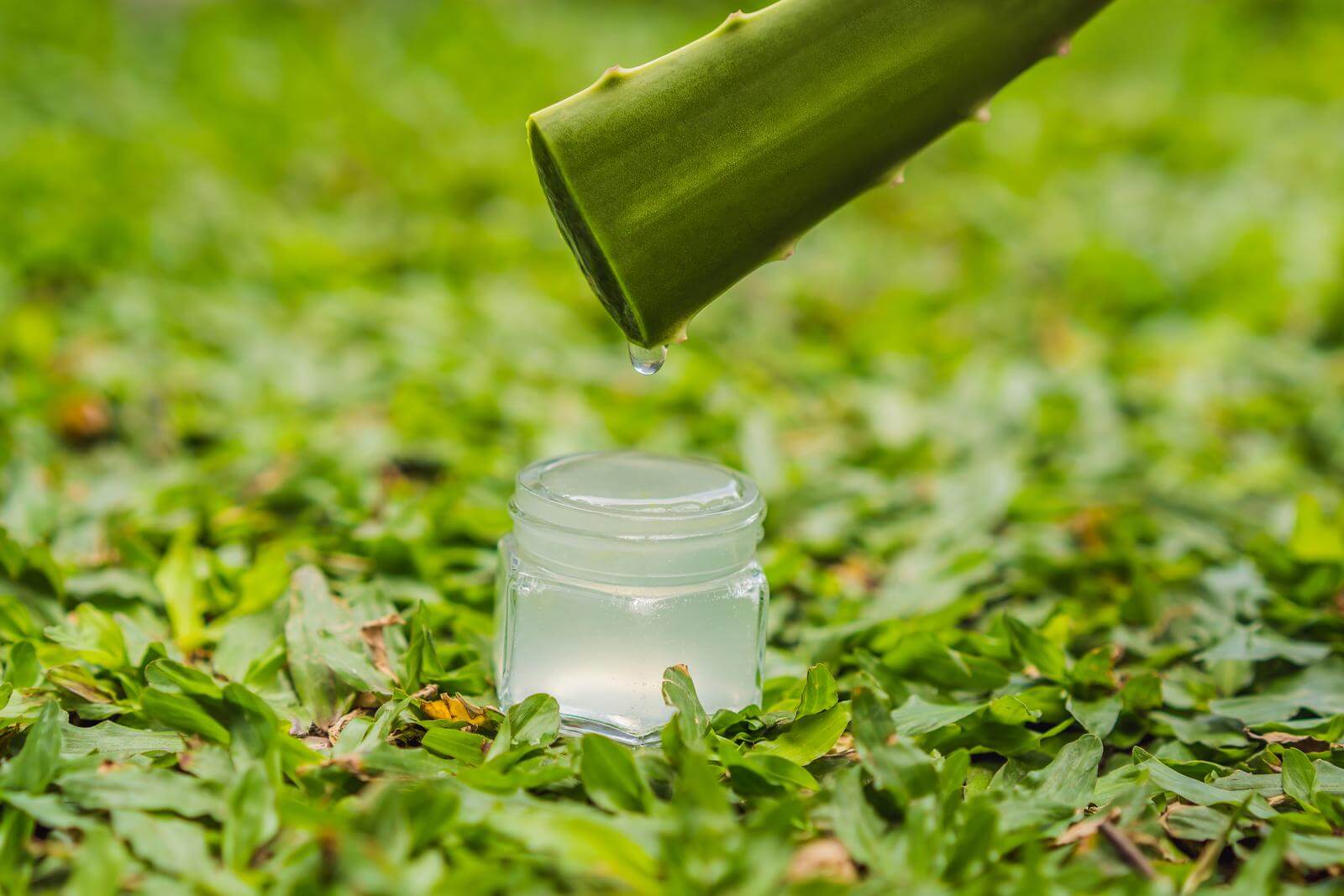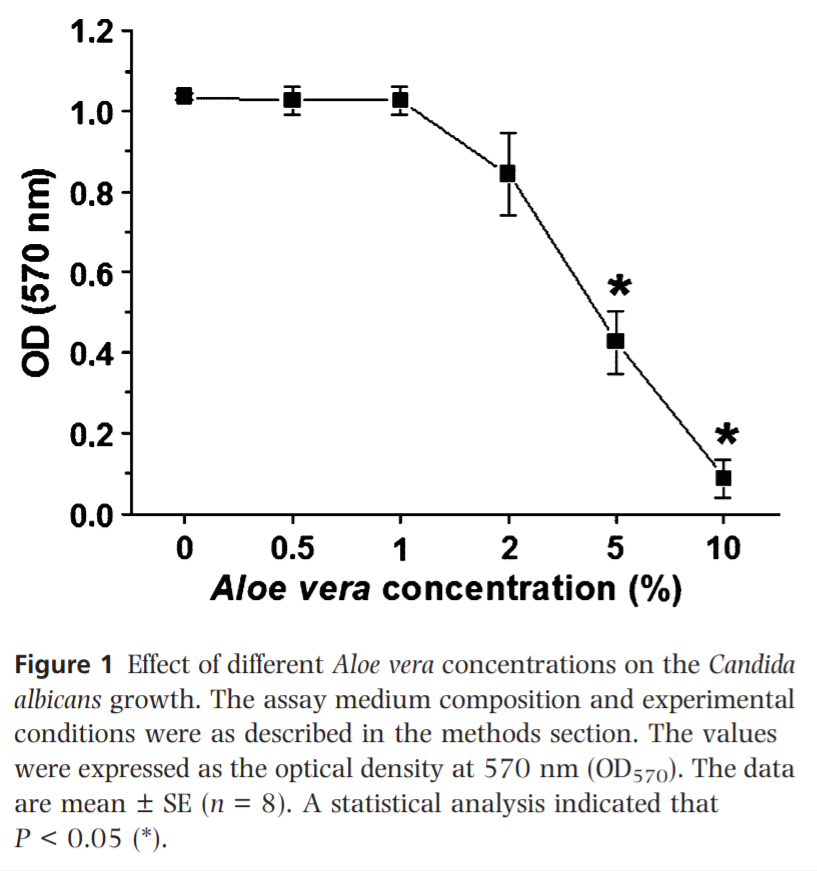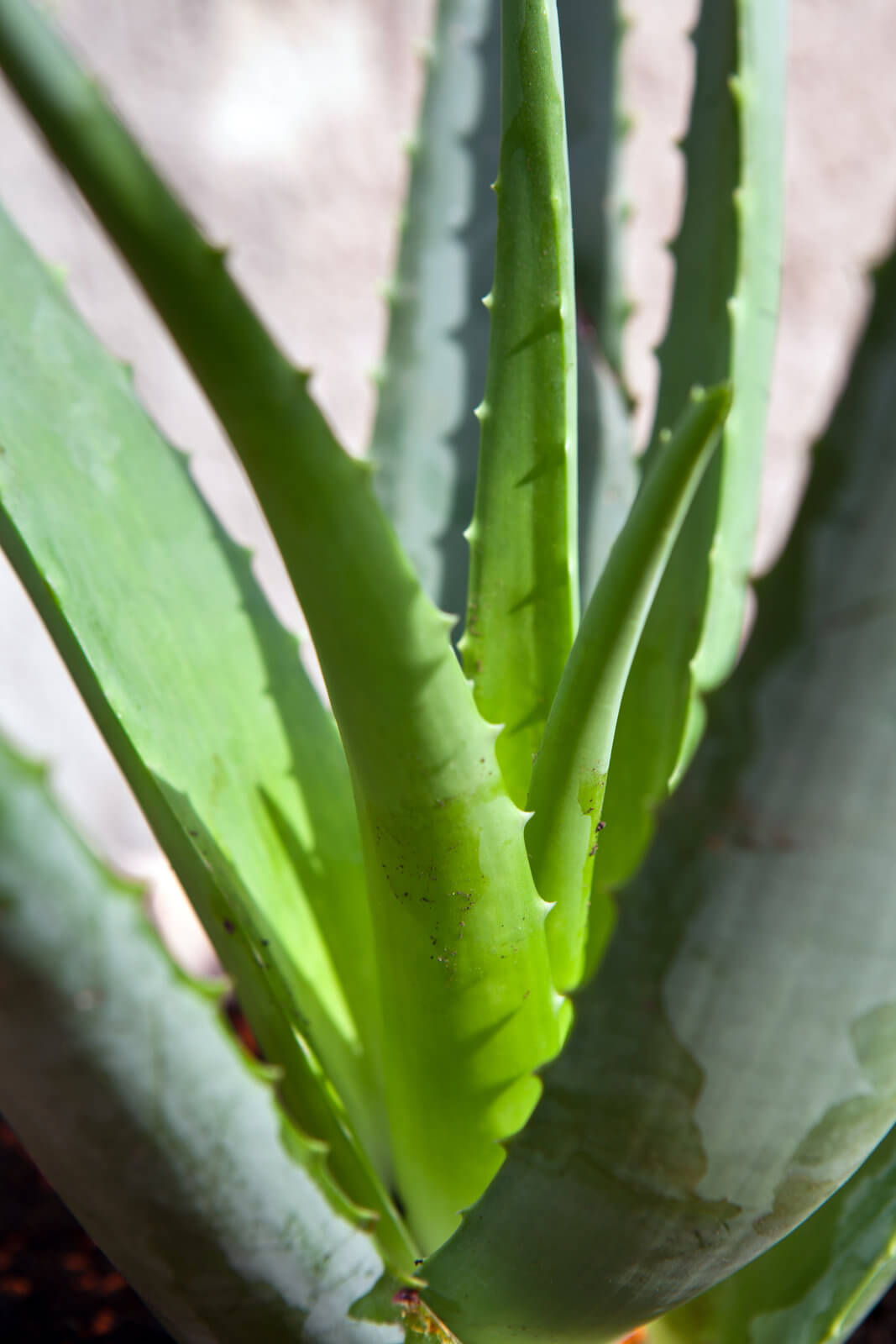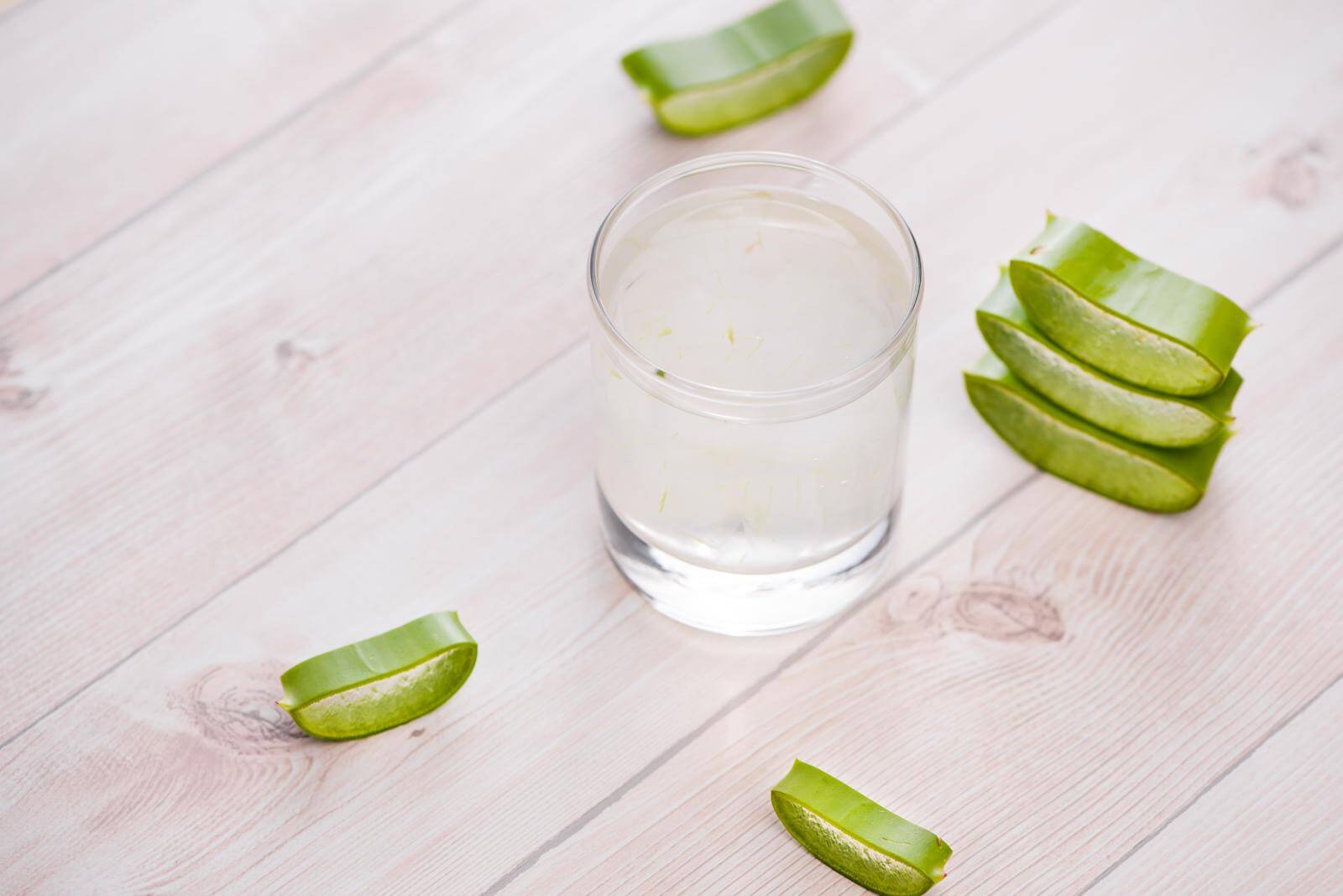See all "Home Remedy" Section Topics

Aloe vera, scientifically named Aloe barbadensis, is a widely used succulent plant that is commonly available. Perhaps what this plant is known best for is healing minor burns. If you’ve ever had a sunburn, you may have used some type of aloe vera product to soothe the irritated skin. As research shows, using aloe vera for yeast infections, is also actually a good idea.
Although not extremely powerful against Candida (the microscopic fungus responsible for most yeast infections); it does stop Candida growth. Aloe vera can even check the rate at which yeast cells transform into their more dangerous germ tube form. Consequently, aloe vera makes a viable natural remedy, you can use from home to get rid of Candida problems!
Reactions to the topical use of aloe vera are uncommon; but, if you have a known allergy to a member of the Liliaceae family (i.e., the lily family—members include onions and garlic), you may have some chance of being allergic to aloe vera. If you want a quick way to get some idea of what this plant will do to you, you can perform a patch test.
Just put a small dab of the gel on an insensitive part of your skin. If your skin doesn’t show any adverse reaction after an hour or two, you’ll have a good possibility that using it elsewhere, in greater quantities, won’t be a problem.
Aloe vera gel alone will start fighting off yeast infections; but, like many other explanations on Candida Hub say; using a few other natural items, along with aloe vera, will be a great idea. Additional essential oils or herbs will help to really kill off the invasive yeast plaguing your body.
And, aloe vera makes a great medium to put these natural items in, as it can help to reduce inflammation and itchiness. So, if you’d like to experience the soothing, cooling, salubrious power of aloe vera, go ahead and start using it—as research has shown, it does halt yeast growth!
A 1/2 Day & Yeast is Gone!
Linda Allen suffered from yeast infections for years. Through researching natural medicine & Candida, she found an efficacious solution!
Linda is one expert you want on your side! Let her show you how to get rid of a superficial yeast infection in just 12 hours; AND, keep it gone!
A 60-day, 100% money back guarantee is provided.
Visit Official Site!Research on Aloe Barbadensis (Aloe Vera)

The first study we will explore, looked at how aloe vera would inhibit three different microorganisms: Staphylococcus aureus, Escherichia coli, and Candida albicans. Thus, it is relevant to this examen; as Candida albicans is known to cause the majority of yeast infections (about 85% of them).
This important research, was published in the International Journal of Current Microbiology and Applied Sciences [3.3 (2014): 1022-1028]. According to the introduction, aloe vera is a succulent plant that may be indigenous to the northern section of Africa. Aloe vera is also known by the name Aloe barbadensis; and, it belongs to the Liliaceae (lily) family. Aloe vera is similar to cactuses and it loves to grow in dry, hot environments.
The study used 790 grams of aloe vera gel that was scrapped out of the aloe vera plant’s leaves. The gel that was collected, was smooth in texture after it was ground; and, it was also colorless. This gel was then mixed with three different solvents—100 mg of each solvent was used. The solvents utilized included water, methanol, and ethanol.
After the gel and the solvents were mixed, the mixtures were allowed to rest for 72 hours; and, then were filtered. The study found that the minimum inhibitory concentration (the lowest amount tested that inhibits the growth of a microbe), when used on Candida albicans, of aloe vera gel water extract was a 0.50 mg / mL concentration.
Thus, a weak concentration of aloe vera should have some adequate inhibitory effect against Candida albicans. The authors concluded their study with the following recommendation:
Aloe vera could be used as alternative to chemicals used in medication. This weil help to reduce the toxicity of the chemicals used in medications. It is recommended that ethanol extraction is most preferable to other extraction methods.
International Journal of Current Microbiology and Applied Sciences [3.3 (2014): 1022-1028]
Another study, published in the Journal of Animal and Veterinary Advances [8.1 (2009): 99-102], also discusses aloe vera; and, includes how well this natural herb will work in vitro (in glass—outside of the body) against Candida albicans. According to the authors, aloe vera has more than 200 active chemical compounds, and over 75 nutrients.
A significant amount of scientific research has demonstrated that aloe vera has antifungal, antibacterial, antiviral, analgesic, anti-tumor, and anti-inflammatory properties.
In this research, leaves of the Aloe vera plant were cold pressed to produces juice. The study then tested this juice on various bacteria and Candida albicans. Among these microorganisms, Candida albicans was found to be the most susceptible to the aloe vera juice.
The juice from this plant caused around a 30 millimeter zone of inhibition on Candida albicans. The tests also found that aloe vera juice, in general, was able to inhibit Gram-positive bacteria, but usually did not have any effect on Gram-negative bacteria. And, of course, Candida species are not bacteria; they are fungi.
The next study we will review, also examined how aloe vera gel, dissolved in the solvent Dimethyl sulfoxide (DMSO), would work at inhibiting Candida albicans. This research was published in the International Journal of Biomedical and Advance Research [3.3 (2012)].
The study used various bacteria and one other fungus besides Candida albicans: Penicillium. The study found that 400 mcg / mL of the aloe vera gel extract produced a zone of inhibition of 11 millimeters. The Penicillium was also inhibited by the aloe vera gel extract.
Candida Germ Tubes & Aloe Vera
The next study we will explore, looked at how aloe vera extract would affect Candida albicans germ tube formation and general growth. This research was published in the excellent journal Mycoses [55.3 (2012): 257-261]. As you may know, when conditions are correct, many species of Candida (including Candida albicans) can start to transition into germ tubes (hyphal growths).
When regular single cells of this yeast (known as blastoconidia) start to grow into long tubes, this often increases the virulence of the yeast. Stubborn yeast infections can be a result of too much yeast attached to the outer layers of body cavities (such as the vagina or intestines).
So, if you can reduce germ tube formation, this can greatly help allay the severity of a yeast infection.
It is important to note that this study was using a glycolic aloe vera extract; having properties that are different than plain aloe vera gel. The study used concentrations of this extract that ranged from 0.5% to 10% v/v (v/v means a volume / volume ratio; which means that a 10% v/v solution will have 10% of the total volume comprised by the solute. More on this here.).
The study put yeast cells into small wells and added the aloe vera extract to them. This mixture was then incubated for 24 hours. The study found, that when Candida albicans was exposed to a 10% concentration of aloe vera extract, growth of this yeast was stopped by about 90%. This reduction of growth was also correlated to a reduction in Candida albicans ability to begin hyphal germ tube production.
The following chart was taken from the study, and shows how increasing concentrations of the aloe extract affected this fungus’ development. The y-axis of the chart shows the optical density (labeld as optical density at 570 nano meters: OD570) of the yeast; which was determined using a Synergy HT Multi-Detection Microplate Reader.

Eliminate Bacterial Vaginosis & Vaginal Odor
Jennifer O’Brien is one prominent expert on BV that knows how to get rid of vaginal odor. BV is a common infection that you don’t have to put up with.
Jennifer will show you how to naturally eliminate vaginal odor in just 3 days.
A 60-day, 100% money back guarantee is provided.
Visit Official Site!How to use Aloe Vera for Candida Infections

Aloe vera is a soothing gel that can reduce inflammation; thus, it is a great choice to use on a yeast infection. Inflammation may allow Candida to spread with greater ease; as this yeast may colonize damaged areas of the skin better. Candida can cause red areas of skin—this is often a sign of a yeast infection.
So if you have a red, inflamed penile yeast infection for instance, aloe vera may help to allay inflammation—making the skin possibly less conducive to yeast growth. Additionally, aloe vera contains the enzyme bradykinase, a compound that can reduce inflammation and itchiness (Surjushe, et. al; 2008).
So, if your genitals are plagued by a nagging yeast infection itch, aloe vera gel (or juice) may be able to help provide some much needed relief to this area.
However, aloe vera alone may not be able to really kill off a yeast infection quickly. So, it is wise to add in some antifungal essential oils or herbs to aloe vera; to get a decisive victory over your yeast infection. There are a wide variety of herbs and essential oils that possess antifungal power; and, on this website we break down many of them and relate professional scientific research that validates these natural remedies.
Aloe vera gel will make an excellent medium to use with these natural remedies. You may want to even soak aloe vera gel in a mixture of herbs for a day or more before you use it. Either way, bringing in more yeast killing power to your treatment should quicken your recovery!
For more information on these items you can check out essential oils for yeast infections and herbs for yeast infections sections on Candida Hub.
Clair Goodall: Author & Nature Lover
Clair Goodall is a bee-obsessed natural medicine convert from Minnesota. She is one expert you might want to know more about!
Clair will help you protect you and your family from toxic products and chemicals and help you discover solutions from nature.
Also, Clair’s book is backed by a 60-day, 100% money back guarantee
Visit Official Site!Other Natural Therapeutic Uses for Aloe Vera

A study, published in Seminars in Integrative Medicine [Vol 1, No 1 (March), 2003: pp 53-62], also outlined some of the ways aloe vera can be used as a natural medicine. Some of the reported pharmacologic properties of this plant include: protecting against hypoglycemic stress, the amelioration of burns, frostbite, and wounds; and, protecting against fungal infections, inflammation, and gastric problems.
The study reported that other research had shown that aloe vera gel extract allowed for more rapid burn healing in a guinea pig. The study did note, that some research has shown aloe vera does not help wound healing; however, the authors stated, that as wound healing becomes better understood, more data becomes available that supports the view that aloe vera gel enhances wound healing.
The authors conclude, that aloe vera does contain several active chemicals, possessing wound healing, immunomodulatory, and antiinflammatory effects. However, the authors relate, that since the chemical makeup of aloe vera can be somewhat different given certain conditions, there may be some discrepancy between the results of scientific studies that attempt to verify this plant’s therapeutic ability.
Linda Allen’s 12 Hour Yeast Infection Solution

Linda Allen is one woman who suffered for nearly a decade with yeast infections. Linda’s Candida troubles began in her late teen years around the time she developed a sinus infection.
Linda went many times to a medical doctor to get help; and, as many women discover, the prescriptions she was prescribed only temporarily fixed her problem. As time went on Linda’s health continued to decline. And, Linda’s frequent medical expenses had severely drained her finances.
Linda was not sure what was going on with her, and she was not able to find a real, effective solution to get back her health.
Linda’s life did finally change for the better when she made a visit to a naturopath. The naturopath quickly knew that Linda’s bad health was a result of a systemic yeast infection. Linda finally understood that there was an excessive amount of yeast living in her body; and, that this was the source of her problems.
Linda decided to diligently study natural medicine that related to Candida. Linda also asked the advice of medical practitioners that were kind enough to lend her some time. Linda also tried a whole host of alternative treatments that claimed to help with Candida problems.
Eventually Linda did arrive at a powerful, effective, and natural solution for systemic and other types of yeast infections. Linda spent close to 12 years compiling this solution, and used it with great success on herself. Linda also went on to write a comprehensive book explaining how to repeat her success and permanently end Candida health issues.
Linda’s treatment plan is so effective she guarantees you will get rid of a genital or oral yeast infection in just 12 hours time using her method. And, if you have a systemic yeast problem, Linda’s book will also show you how to permanently get rid of this as well.
Linda’s book is published via a large, reputable publisher owned by the U.S. based firm Keynetics Incorporated. Since Linda first published her book in 2004, over 100,000 people from around the world have successfully been delivered from their yeast infections.
If you try Linda’s book and your yeast infection does not go away within 12 hours, you can quickly get all of your money back by contacting Linda’s publisher (who also handles the transaction process).
To discover more about Linda’s personal struggle with Candida and learn about her journey to yeast infection freedom; you can find out more at Linda Allen’s website. There you will be able to see many testimonials from others who took a chance on Linda’s treatment and see some of the other bonus books Linda includes with hers.
Author: Mr. Nicholas Gross

Nick Gross is a natural medicine enthusiast who has been researching and writing about natural medicine since 2008. Nick is primarily a web developer but also researches and authors written and video content about natural health. Nick has a bachelor’s degree in Management Information Systems from the University of Northern Iowa.
Disclaimer
The information on this website is not a prescription for anyone. This information is for informational or educational purposes only, and is not a substitute for professional medical advice or consultations with healthcare professionals.
Affiliate Disclosure
Some of the links provided on this website are affiliate links. When a purchase is made through these links, Candida Hub earns money from commission. This helps to keep the website up and helpful to people for free. Thank you for any support!
Stay Up to Date
If you enjoyed this article, consider following / liking our Facebook page. This page is primarily utilized to alert followers of new articles that are put on Candida Hub. Candida related news is also discussed. While you are there, you can see what has been more recently added to Candida Hub.
SOURCES:
- http://www.ijcmas.com/vol-3-3/Mbajiuka-Chinedu-Stanley2,-et-al.pdf — Stanley, M., O. Ifeanyi, and O. Eziokwu. "Antimicrobial effects of Aloe vera on some human pathogens." International Journal of Current Microbiology and Applied Sciences 3.3 (2014): 1022-1028.
- https://www.researchgate.net/publication/Investigation_of_In_vitro_Antimicrobial_Activity_of_Aloe_vera_Juice — Alemdar, Suleyman, and Sema Agaoglu. "Investigation of in vitro antimicrobial activity of Aloe vera juice." Journal of Animal and Veterinary Advances 8.1 (2009): 99-102.
- http://dx.doi.org/10.7439/ijbar.v3i3.294 Antonisamy, Johnson Marimuthu Alias, et al. "Anti-bacterial and antifungal activity of Aloe vera gel extract." International Journal of Biomedical and Advance Research 3.3 (2012): 184-187. Full Text PDF
- http://dx.doi.org/10.1111/j.1439-0507.2011.02079.x — Bernardes, Ivy, et al. "Aloe vera extract reduces both growth and germ tube formation by Candida albicans." Mycoses 55.3 (2012): 257-261. PubMed, Full Text PDF
- http://umm.edu/health/medical/altmed/herb/aloe — Deliniation of Aloe and its uses in medicine from the University of Maryland Medical Center.
- http://dx.doi.org/10.4103%2F0019-5154.44785 — Surjushe, Amar, Resham Vasani, and D. G. Saple. "Aloe vera: A short review." Indian journal of dermatology 53.4 (2008): 163. PubMed Full Text
- http://dx.doi.org/10.1016/S1543-1150(03)00005-X — Choi, Seongwon, and Myung-Hee Chung. "A review on the relationship between Aloe vera components and their biologic effects." Seminars in integrative medicine. Vol. 1. No. 1. WB Saunders, 2003.







